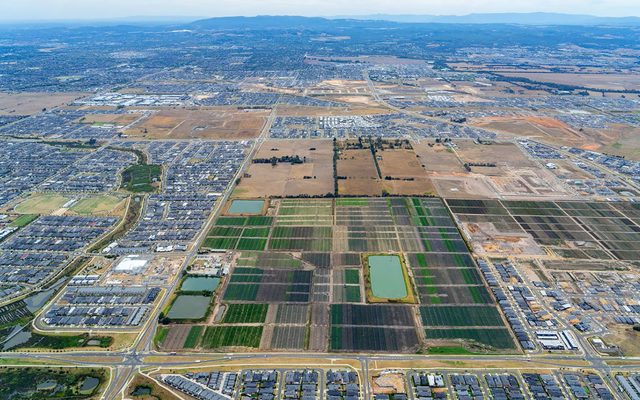This article is from the Australian Property Journal archive
AUSTRALIAN house prices are 6.8% below their peak, according to the latest CoreLogic data, as Brisbane posted its first negative year-on-year change for the first time since 2012, and Sydney moved into double-digit annual declines for the first time since the early 1980s.
Dwelling values fell by 0.7% in February, the 14th drop in the past 16 months, and have returned to levels last seen in September 2016. Prices are still 18% higher than they were five years ago.
CoreLogic head of research, Tim Lawless said the national rate of decline eased relative to January and December, when dwelling values were down by around 1%.
“However, the February results remain overall weak, with the geographic scope of negative conditions broadening.”
In annual terms, Hobart showed the strongest market movement with values up 7.2%. Sydney was down by 10.4% and Brisbane by 0.5%, while Adelaide rose 1.0% and Canberra 3.4%. Melbourne’s downturn should see annual decline figures hit double digits over the coming months as well, with values currently 9.1% lower over the year.
Both Perth and Darwin saw their annual pace of decline worsen after a small easing, down by 1.5% and 1.7% over the month respectively, with Perth posting its sharpest-ever monthly fall.
“The fact that we are seeing weakening housing market conditions across regions where home values were previously rising at a sustainable pace and economic conditions are relatively healthy is a sign that tighter credit conditions are having a broad dampening effect on buyer activity,” Lawless said.
Data from the Australian Bureau of Statistics showed household lending continued to fall in December, with the seasonally adjusted value of new lending commitments for investment dwellings plummeting by 27.8% year-on-year, and by 16.2% for owner occupiers.
Lawless said that while a slowdown in investment was a key driver of slowing housing markets since 2015, the recent decline in owner occupier lending was “far more significant” considering the segment more than twice the value of investment lending.
“The long-running reduction in investment lending has understandably impacted the Sydney and Melbourne housing markets more than others, considering investment activity was heavily concentrated in these cities, however the reduction in owner occupier credit explains a lot about the broader softening in housing market conditions more recently,” he said.
“Stricter lending standards are a logical outcome following the royal commission and we are likely in the early phases of a ‘new normal’ for mortgage lending where borrowers will face closer scrutiny around their expenses and ability to service a loan and conversion rates on loan applications are likely to remain lower than they have been over prior years.”
AMP Capital held its forecast of a top-to-bottom fall in prices in Sydney and Melbourne of 25%, spread out to 2020, as chief economist, Shane Oliver dismissed the recent easing of price falls and improved auction results in the major cities as “just a bounce”.
“February often sees a seasonal rise in clearance rates – a bit like a delayed Santa rally, clearance rates always bounce around a bit and a bounce was likely at some point as sooner or later sellers would start to accept more realistic prices.”
He said a crash landing – a national average price fall in excess of 20% – remains unlikely in the absence of much higher interest rates or unemployment.
“But it’s a significant risk given the difficulty in gauging the impact of credit tightening and how investors will respond as their capital growth expectations collapse at a time when net rental yields are around 1% to 2%.”
Capital Economics expects an eventual top-to-bottom fall in prices nationally by 15%. The firm’s Australia & New Zealand economist, Ben Udy said this would be consistent with prices continuing to decline at around their current rate for at least the next 12 months.
“We believe that the downturn will result in weaker dwellings investment and slower consumer spending, which would drive a slowdown in GDP growth from 2.9% in 2018 to 2.0% this year.”
To combat that economic slowdown, the Reserve Bank would need to make a move on interest rates and cut them further by the end of 2019.
CoreLogic data showed Hobart was the only capital city to record a rise in values over the past three months, while Canberra was steady. The remaining capitals all posted falls.
Regional dwelling values were down 1.4% over the past twelve months, compared with a 7.6% fall in capital city dwelling values.
Lawless cited other contributing factors to the downturn as higher supply, a build-up of stock available for sale, fewer foreign buyers and weakened sentiment.
“Helping to offset these headwinds are mortgage rates which are still tracking around the lowest level since the 1960’s and strong labour market conditions in New South Wales and Victoria where unemployment rates are around record lows,” Lawless said.
CoreLogic data showed national settled sales activity was down 12.8% year-on-year, with heavy falls in settled sales activity recorded in the major markets of Melbourne, by 22.1%, and Sydney, by 20.6%.
Australian Property Journal




